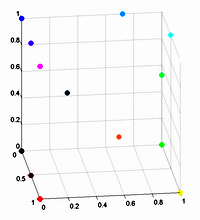June 29, 2007
Cherry 2000
 A discussion on sexbots emerged on Half Sigma. That reminded me of an amusing paper I recently read, Robot Prostitutes as Alternatives to Human Sex Workers (pdf) by D. Levy (from the roboethics section of the 2007 IEEE conference on robotics and automation, lots of fun papers). He makes the argument that while sex robots are under development, the first truly good ones are going to be expensive. Hence it would make more sense to rent them than to buy them, and hence there would emerge robot prostitution ("doll experience rooms" is almost there, but without the robotics). He then goes on to look at the main ethical issues, reaching the conclusion that the biggest problem might be making human sex workers redundant, but that there is apparently nothing inherently wrong with the idea of robot prostitution.
A discussion on sexbots emerged on Half Sigma. That reminded me of an amusing paper I recently read, Robot Prostitutes as Alternatives to Human Sex Workers (pdf) by D. Levy (from the roboethics section of the 2007 IEEE conference on robotics and automation, lots of fun papers). He makes the argument that while sex robots are under development, the first truly good ones are going to be expensive. Hence it would make more sense to rent them than to buy them, and hence there would emerge robot prostitution ("doll experience rooms" is almost there, but without the robotics). He then goes on to look at the main ethical issues, reaching the conclusion that the biggest problem might be making human sex workers redundant, but that there is apparently nothing inherently wrong with the idea of robot prostitution.
My prediction is that in the long run we are going to see a large part of human sexual and erotic desire fulfilled by technogamy (the social and emotional parts might remain between humans). But the limiting factors of robotics (the devices need to be smart enough to take care of themselves) and social acceptance (it must not be a terrible embarassment if your guests find a sexbot in your wardrobe) will take quite some time. It might be an interesting race of preemption between sexbots, good brain-computer interfaces allowing VR and transformative technologies that make mankind postbiological. In the long run we are all technosexuals.
Fixing Sex Selection
 This week on CNE I talk about early gender testing, a technique that elegantly undermines the anti-sex selection rules of Europe. By measuring fetal DNA it claims to be able to determine the sex of the child with high accuracy, only requiring a blood sample and a mail-order genetic test. In societies where people are allowed to test their bodies and have access to abortion this means that it is impossible to prevent sex selection if it is really desired. The pressure in the west seems to be relatively weak, but some couples no doubt want it.
This week on CNE I talk about early gender testing, a technique that elegantly undermines the anti-sex selection rules of Europe. By measuring fetal DNA it claims to be able to determine the sex of the child with high accuracy, only requiring a blood sample and a mail-order genetic test. In societies where people are allowed to test their bodies and have access to abortion this means that it is impossible to prevent sex selection if it is really desired. The pressure in the west seems to be relatively weak, but some couples no doubt want it.
There are three main reasons people claim to be against gender selection:
- Respect for “the given” selecting persons
- Sexism
- Tilted gender ratio
Often these are mere rationalisations for a fundamental distaste to intervene in reproduction. It would be more honest to admit it, but there is not much chance of advancing the debate if both sides are just feeling. On the other hand, it might make it more clear that in a pluralistic society even fundamental issues of human life may have to be individualised. But that is something bioconservatives would never agree with: they want the normative high ground and to be able to ban practices.
Respecting the given
The respecting the given argument is more of an argument about attitude than an argument against a particular outcome. Its typical form is that we should have an "openness to the unbidden" and appreciate life as gift.
This approach has been roundly criticised both academically and non-academically.
The easy part to criticise is the nature of givenness, as some proponents seem to think it is how the given children come about that matters. But imagine that J.A. Millot was right in L’art de procreer les sexes `a volonte (1820) and that the child’s gender is determined by what side the woman lies on when the male ejaculates. Would it make sense to argue that this unpredictability is so important that parents must not pay any attention to their sexual position? Or maybe that they have to flip a coin? "Tails, honey. Lean on your left".
The given sounds convincing as long as its origins are held suitably hazy; then our intuitions about divine interventions, destiny or providence can play freely. When the sources of the given are mere randomness (or lying on one’s side) the given does not seem to hold much impressive power. The attitude towards the given is the important one, because it deals with something real: how people view each other.
The main problem as I see it with appreciating the unbidden is that it clearly isn’t applicable to every situation, but we don’t have any guidelines for when it is important. Should we meekly accept illnesses or crime because they are given by external, unpredictable factors? Nobody argues for that. Should we accept that certain people have a hard time learning as a sign that they should not try hard in school or be given help to overcome their natural problem? Again practically everyone thinks we should overcome the given. It seems that in nearly any area where we can effectively change things we gladly throw out the given in favor of the selected. Critics like Sandel might be right in that it does not make us happier, but it doesn’t seem that respecting the given has much strength as a normative argument or basis for laws.
Holding bad attitudes doesn't seem to be such a threat that laws have top be instituted against technologies that might (and we have so far little evidence for it) promote them. If it is OK to write books reducing respect for other people and urging them to treat each other as disposable tools, then it seems unreasonable to argue that a technology that just might promote the same result should be legally banned. We as a society (or the people holding the view that there is a problem here) might content ourselves to regard sex selection practices as something that is immoral or suspect, but yet should be legally allowed.
Many think that the problem here is that we are selecting a person. But this runs into Parfit's non-identity problem: whatever we do, whether selection happens or not, a different person will result. Brain development is likely a chaotic process with sensitive dependence on initiail conditions. At the most we are selecting subsets of the space of possible people, but these subsets are enormous.
I think again the argument becomes a psychological one: the selection is made for the benefit of the parents rather than the kid. One can try to make this an ethical issue and argue that threatens human dignity since the kid becomes a means to an end for the parents. But unless the parents are actually thinking they want a male heir or a daughter to tend them in old age this end is pretty non-instrumental. They want a kid, and that is the primary goal (otherwise they would not bother with sex selection, and would go straight for abortion). They also prefer a particular kind of kid, but this desire is contingent on the first desire. Hence the kid is not a means to an end. Maybe its sex is a means, but to my knowledge there is no "sexual dignity" that proclaims that one's sex or gender should never be a means but only an end in itself.
The overbearing parents argument is used against all forms of prenatal enhancement, but again the problem seems to be more that bad parenting is allowed than the technologies used. If parents imposing their will on kids is such a great problem, why try to handle it merely by banning a particular expression? Overbearing parents make the lives of their kids difficult in a variety of ways, from "Baby Einstein" toys over early sports training and piano lessions to giving them names like Caesar and telling them that they are expected to grow up into great leaders. Why not ban these practices, or require that a psychologist monitors every childhood? Clearly more children would be helped in this case than in the case of just banning gender selection, so it would be the rational first choice. But instead we have very strong rules allowing parents to bring up their kids in any strange way, as long as there is no physical harm or sexual activity.
Sexism
Sexism is a more obvious issue in sex selection. Sexism is defined variously as assuming one sex being superior to the other, a hatred or dislike of one sex or having a limited and/or false notion of one or more genders.
Clearly ideas about family balancing shows that the value of genders may have a strong variable component: if a family has two boys, the value of a girl increases. But this kind of variable value is hardly what makes sexism undesirable nor is it sexist: instead it represents a valid recognition of how different traits are differently desirable in different situations. Discrimination is bad when it discriminates depending on irrelevant attributes. One might argue that the sex of the next child is irrelevant and a family can be just as happy with three boys, but this must be left up to the family to determine. It cannot be determined by an outside rule that sex is always irrelevant to families.
Sex selection based on the assumption of males (or females) being better, worse or being instrumentally important for some family project is clearly based in a sexist view. But again the problem lies in the sexism, not the ability to implement a sexist policy. As statistics of gender inbalances shows there is differential mortality for genders that differ between cultures: it is frighteningly easy even without gender selection to bias sex ratios by behaving differently towards desired or undesired offspring - and the amount of human pain this kind of "post-birth abortion" causes is obviously far greater than the amount of pain caused by a prenatal abortion.
Again, the rational thing to do is to work against sexism rather than a technology. As the widespread desire for family balancing shows a sexist culture can become relatively non-sexist in just a few generations. Sex selection is also unlikely to entrench traditional sexism, because if it is widespread the imbalances will force a re-evaluation of gender roles.
Gender Ratios
The risk of tilting gender ratios is a practical one. It doesn’t seem to be very relevant in the west, but elsewhere it carries some weight. That also leads to an unfortunate racist undercurrent in the argument: we are doing right, they are short-sighted and immoral. But is a tilted gender ratio that bad?
In the past we have had societies with strongly tilted gender ratios, in particular frontier areas like 19th century Argentine and Singapore and the post-war male depleted Soviet Union. Were they so bad that we must avoid them at all costs? Having many uprooted young men made for a rather volatile society, and they were certainly not the nicest or most cultured places. But they were also destabilised by many other frontier factors, so it is unlikely we can blame the number of men on all of that. Given differences in male and female behavior it may however be likely that a strongly male-tilted society would be more violent.
Right now Armenia tops the ratio list with 115 males per 100 females. China has 112 males per 100 females. That is about 10% above the natural level. Hence the gender selection going on today only produces a relatively minor effect compared to the historical cases (where ratios in society could be 15:1). It seems unlikely that allowing selection would make people orders of magnitude stronger, so the problems caused by sex selection techniques are unlikely to be larger than the old frontier problems.
If the government wants to control the gender ratio, why not add soft controls like taxing the "excessive" gender? Of course, that implies a devaluation of a gender and is to some extent an official sexist policy. And government control over reproduction has practically never had any benign effects.
Overall, gender imbalances are a way of forcing traditional systems to reconsider traditional sex roles. Economically, if males are regarded as more valuable than females they will become more common until the females reach the same value. In theory it would fix gender disparities elegantly. In practice there is a ~15-20 year delay that could induce oscillations.
Overall, I'm not worried that sex selection will tear society apart. Societies have handled far more tricky situations before, usually creatively. I'm more worried about the tendency to think that bans of technology can limit already extant bad social behaviors. That suggests an overconfidence both in the power of laws and our ability to predict complex social consequences, and underconfidence in actually changing cultural mores. Humanists ought to be careful about that.
June 27, 2007
Creative Emicracy
 Erik at Framtidstanken points out that the Emicrat party now is the largest party outside parliament. Emicrats are people who vote with their feet, shopping between democratic national states. Erik estimates that between the last two elections 2.6% of the voters made an emicratic choice, making the "emicratic party" the largest of the parties outside parliament. He also points out that this is a democratic choice that sends signals about how the citizens are seeing the country in relation to other countries. It would be interesting to find out why many younger women move out, for example - maybe the opportunities are not so good in Sweden as it is claimed?
Erik at Framtidstanken points out that the Emicrat party now is the largest party outside parliament. Emicrats are people who vote with their feet, shopping between democratic national states. Erik estimates that between the last two elections 2.6% of the voters made an emicratic choice, making the "emicratic party" the largest of the parties outside parliament. He also points out that this is a democratic choice that sends signals about how the citizens are seeing the country in relation to other countries. It would be interesting to find out why many younger women move out, for example - maybe the opportunities are not so good in Sweden as it is claimed?
I'm a happy emicrat myself. Moving to the UK was not only a good career opportunity but also placed me in a society where a libertarian viewpoint is not regarded as a bizarre aberration. And I wonder why I find so many Swedes here in Oxford - while I might notice them more, there seem to be objectively far more of them that one would expect when comparing with other nationalities like Germans or Finns. Comparing this with how the people in media I know are moving, I'm starting to think that Sweden is suffering from a relatively specific brain drain of creatives. On average Sweden draws academics (including top researchers), but I'm having the feeling that it retains those who enjoy fixed structures rather than being intellectual entrepreneurs. One in five highly cited Swedish scientists will move abroad, but few foreign scientists of equal rank replace them. I have no strong evidence for the entrepeneurship bias yet (how do we measure it?), but if it is true the emicrats are telling the government something very important - and other places will become the clusters that invent and profit from the new. Sweden might be planting many seeds, but it seems rather bad at harvesting them.
On the other hand, maybe this is just specialisation. Maybe it is better to leave the chaos, surprises and struggles to some region and keep the smooth progress in others? The emicrats are moving to the regions they like, making the regions more like them.
[ Calculating emicracy is somewhat tricky. About 15,000 Swedish citizens immigrate and 20,000 emigrate each year, but some might do both (60% return eventually). About 200,000 Swedes live abroad, according to SCB. So at the most (assuming a constant external pool and separate emigrants and immigrants) that would be 3.7%, while just counting the pool gets 2.2%. Still, there is a sizeable number of Swedish citizens moving around (we are not counting immigrant citizens-to-be here). ]
June 20, 2007
Ideas of the EGGheads
 Extreme Green Guerrillas (via www.we-make-money-not-art.com) is Michiko Nitta's graduation project at RCA. She takes extreme green lifestyle to the extreme, inventing the “Extreme Green Guerillas” (E.G.G.): "They are a network of amateur self-sustaining people who have shortened their lifespan to sustain the ultimate green lifestyle. Whilst going to extreme lengths to protect the environment, they try to enjoy a decadent quality of life by utilizing urban waste and biosystem. This consists of embracing emerging technology to develop the ultimate green solution."
Extreme Green Guerrillas (via www.we-make-money-not-art.com) is Michiko Nitta's graduation project at RCA. She takes extreme green lifestyle to the extreme, inventing the “Extreme Green Guerillas” (E.G.G.): "They are a network of amateur self-sustaining people who have shortened their lifespan to sustain the ultimate green lifestyle. Whilst going to extreme lengths to protect the environment, they try to enjoy a decadent quality of life by utilizing urban waste and biosystem. This consists of embracing emerging technology to develop the ultimate green solution."
This involves using RFID marked migratory animals for messaging (since it would be bad to play into the hands of the corporations running normal networks), giving up on healthy or fairtrade food (since it has to be transported) in favor of locally produced food and genetically modified urban vermin like the Piguail Pigeon-Quail hybrid and the Rattit rat-rabbit hybrid. And at 20 they get an earring that will euthanize them painlessly at 40.
It is a nicely researched and designed piece, which neither seems to be satire over green extremism nor buying into it. Rather, it shows that radical solutions are possible if somebody just wants to do them. At the same time the EGGs give the impression that they have also become a kind of parasitic urban vermin, dependent on the infrastructure they claim to work against.
 The report on recycling in The Economist June 11 instead shows another approach. Thanks to emerging single stream recycling it is becoming increasingly simple to do: rather than laboriously separating all substances in the home (with varying correctness) and taking up excessive space on the sidewalk the separation can increasingly be done at the processing plant. This improves recycling rates, saves time and money, and achieves the vision expressed by Bruce Sterling: "Make the things do the Green thinking". Because if you have to rely on people doing it, they will only do it when they are filled with ideology or it profits them directly.
The report on recycling in The Economist June 11 instead shows another approach. Thanks to emerging single stream recycling it is becoming increasingly simple to do: rather than laboriously separating all substances in the home (with varying correctness) and taking up excessive space on the sidewalk the separation can increasingly be done at the processing plant. This improves recycling rates, saves time and money, and achieves the vision expressed by Bruce Sterling: "Make the things do the Green thinking". Because if you have to rely on people doing it, they will only do it when they are filled with ideology or it profits them directly.
This is the exact opposite of the recycling being promoted in Sweden and Britain, where ideology seems to be dominating over all other concerns. Back where I lived in Stockholm they introduced a new system with great fanfare a few years back. The old trash chutes were modified by the addition of a plastic partition wall to only accept newspaper (right) or paper (left). Kitchen waste should go into the new pneumatic chute on the bottom floor. Everything else (glass, plastics) should go to the boxes on the street, except for those things that should go the the "environment cottage" on the yard. A proud banner with a grand sunrise (or was it a sunset?) proclaimed: "Recycling: for your childrens' and their children's childrens' future!" That my grandchildren apparently did not get any future might be a first sign of the problems of the project.
A leaflet arrived, explaining it all in very simple Swedish. Heavily ideologically biased, it protrayed the sceptical voice that asked questions as a curmudgeonly plastic bag. That the area had many people who might not understand Swedish well enough did not deter the organisers, you could order more leaflets in translation for your family. That the oversimplified explanations did not fully explain how everything was supposed to work was however ignored (this is a trend I found recently on the Oxford Council website, where the new recycling and waste disposal system is so educational and colorful that nobody can figure out whether they can throw away their kitchen waste tomorrow or not). Mistakes were made (kitchen waste in the paper chute!) and the other side of the project showed up: angry, threatening signs.
 The streetside collectors tended to overflow, attracting rats and posing a real fire hazard. The plastic separator of the chute system of suffered damage because bundles of newspapers of course fell along it 14 storeys, mixing up the paper types. The pneumatic chute only worked with the neatly biodegradable paper bags delivered by the project, not the "ecofriendly" paper bags from the store. The mess in the environmental cottage first led to its temporary closure, and when enough junk had begun to pile up around it, to hiring a man to guard it during very restricted opening hours. If your television set imploded you better store it at home until next thursday (of course, people still just put the junk around the cottage. At least it made the playground far more interesting!)
The streetside collectors tended to overflow, attracting rats and posing a real fire hazard. The plastic separator of the chute system of suffered damage because bundles of newspapers of course fell along it 14 storeys, mixing up the paper types. The pneumatic chute only worked with the neatly biodegradable paper bags delivered by the project, not the "ecofriendly" paper bags from the store. The mess in the environmental cottage first led to its temporary closure, and when enough junk had begun to pile up around it, to hiring a man to guard it during very restricted opening hours. If your television set imploded you better store it at home until next thursday (of course, people still just put the junk around the cottage. At least it made the playground far more interesting!)
The fault of the project was the ideological drive. The landlord, the council, environmental and educational organisations all tried to do the right thing. But if the people who are supposed to live in a green way are not enthusiastic or involved in the design process it will not work. Anything that forces people to change their habits or expend extra time, money or energy will fail unless it is rigidly enforced (which is how recycling is often handled - including measures such as spy cameras recording "criminals" that make mistakes in what goes where or ex-police "trash spies" that monitor the recycling) or people are as ideological as the EGGs. But the majority will never be that radical, and hence green solutions have to be convenient. Single stream recycling does not require the dedication of the EGGs, yet it provides a major environmental benefit.
There are likely many other "unbelievable" solutions to environmental problems. It is interesting to see how quickly the idea of carbon sequestration has gone from laughable to seriously considered - even if it never works out it shows how easy an environmental debate can get locked into a standard solution set (and where are the well-funded studies of how to adapt societies to climate change? Again, something which ought to be an obvious response has largely been ignored). Genetically modified organisms, whether for fuel production, manufacture or safety could fulfill a host of very green purposes - but they will of course have to overcome a compact ideological resistance that is likely more based on values than any rational facts. Movements like the Viridian Design Movement seem to be open to many interesting possibilities (which immediately leads to the questions what possibilities they don't recognize), and hopefully they will convince the rest of the environmental establishment that design works better than EGG earrings and trash spies.
Paranoid or Corrupt?
 This week on CNE: Putin protects the precious bodily fluids of Russians from becoming bioweapons. In a bout of paranoia (?) Russia has banned export of human biological material, threatening many medical trials and making things hard for many patients. According to Kommersant this may be due to fears that such materials will be used to develop ethnic bioweapons against russians. The customs service claims they are just fighting organ theft. A more cynical guess would be that Putin et al. want to ensure Russia develops its own lab industry, and that the government gets a lot of say in it. The claims by the customs service that proper medical companies have nothing to fear also ring a bit hollow given that Russia ranks on par with Honduras and Rwanda in the corruption perceptions index 2006. With unclear rules open to interpretation it would take a miracle for corruption not to affect the movement of samples.
This week on CNE: Putin protects the precious bodily fluids of Russians from becoming bioweapons. In a bout of paranoia (?) Russia has banned export of human biological material, threatening many medical trials and making things hard for many patients. According to Kommersant this may be due to fears that such materials will be used to develop ethnic bioweapons against russians. The customs service claims they are just fighting organ theft. A more cynical guess would be that Putin et al. want to ensure Russia develops its own lab industry, and that the government gets a lot of say in it. The claims by the customs service that proper medical companies have nothing to fear also ring a bit hollow given that Russia ranks on par with Honduras and Rwanda in the corruption perceptions index 2006. With unclear rules open to interpretation it would take a miracle for corruption not to affect the movement of samples.
Of course, ethnically targeted bioweapons are a nasty possibility (imagine something based on the infamous mousepox hack but with the killer IL-4 a gene under regulatory control so that it only expresses in the presence of an ethnic marker - a mild disease that is spread by everybody but becomes lethal to a particular group). But the way to stop them is not to prevent the escape of genetic material, because that would require hiding the citizens behind an iron curtain (worked great last time, didn't it?). It is more efficient to make the bioweapons useless by increasing the genetic diversity of the population.
June 19, 2007
Repulsicolor
 I recently needed to color a number of objects in such a way to make them as identifiable from each other. The normal colormaps found in Matlab tend to be graded, making it hard to distinguish objects. So I whipped up a little Matlab function to distribute colors "optimally" for maximal distance (included below the fold).
I recently needed to color a number of objects in such a way to make them as identifiable from each other. The normal colormaps found in Matlab tend to be graded, making it hard to distinguish objects. So I whipped up a little Matlab function to distribute colors "optimally" for maximal distance (included below the fold).
The method treats each color as repulsing the other colors with an inverse hypercubic force. The walls of the RGB cube are impenetrable and force the colors to remain inside.
Why not an inverse quadratic force? The reason is that I prefer to get colors in the inside of the cube and not just on the surface: the more slowly decaying low-order forces tend to drive every color onto the surface.
The method works surprisingly well for a reasonable number of colors. Beyond 50 the stepsize is too large to get stabilization, but by now the number of colors is so large that they are not easily identifiable anymore and one could just make a random colormap.
I have tried it in HSV space too by confining points to the HSV color cone. While the method works roughly right, I'm not too pleased with the results. Colors tend to distribute nicely in terms of layers of value and across the top full value circle, but they have no reason to align with the primary colors and this tends to give a muddled look to the colormaps. Maybe it would be worthwhile to try it in the CIE colorspace.
function col=makeoptcolor(N)
% colormap = makeoptcolor(N)
%
%Make colormap with maximal distance between %N colors. Distributes the colors in the RGB cube %using 1/r^4 repulsion. The colormap is %unordered. The method is stable up to about
% 50 colors; beyond that it is simpler to just %generate them randomly.
%
% Anders Sandberg 2007
rand('seed',1);
% Same map is generated each time
r=rand(N,1);
g=rand(N,1);
b=rand(N,1);
h=0.1;
for t=1:100
for i=1:N
dg=g-g(i);
db=b-b(i);
dr=r-r(i);
d=(dg.*dg+dr.*dr+db.*db);
if (sum(d==0)==1)
fr=-sum(dr./(.000001+d).^2)/N;
fg=-sum(dg./(.000001+d).^2)/N;
fb=-sum(db./(.000001+d).^2)/N;
r(i)=r(i)+h*fr;
g(i)=g(i)+h*fg;
b(i)=b(i)+h*fb;
if (r(i)<0) r(i)=0; end;
if (g(i)<0) g(i)=0; end;
if (b(i)<0) b(i)=0; end;
if (r(i)>1) r(i)=1; end;
if (g(i)>1) g(i)=1; end;
if (b(i)>1) b(i)=1; end;
else
r(i)=rand;
b(i)=rand;
g(i)=rand;
end
end
end
col=[r g b];
June 15, 2007
Politics, Nanotechnology and Palestina
 I have an entry on Overcoming Bias: Tell Me Your Politics and I Can Tell You What You Think About Nanotechnology where I bring up the rather worrying results of Kahan et al. about how people decide whether a new technology is risky or not. They don't do it based on fact, but rather emotion and cultural assumptions.
I have an entry on Overcoming Bias: Tell Me Your Politics and I Can Tell You What You Think About Nanotechnology where I bring up the rather worrying results of Kahan et al. about how people decide whether a new technology is risky or not. They don't do it based on fact, but rather emotion and cultural assumptions.
This is hardly news, as anybody who has been involved in the debates about emerging technologies can tell. But it is suggesting that public deliberation and political decisionmaking about these areas is always going to be fundamentally non-rational.
One obvious response is to assume that we should not bring emerging technologies to the attention of the public, since they will not contribute any rational risk analysis. But that assumes that the experts involved are not self-selected to have particular cultural traits that get them interested in the field in the first place, and hence already biased.
Jef Allbright points out that debate 'has never been about facts and truth, but about subjective awareness of how to promote one's values , whatever they might be. We can be thankful that the universe provides a consistent ratchet effect, selecting for "what works."' That may be true, but for some areas we want as much rationality as possible as early as possible - waiting for 'what works' to do its job can sometimes take a surprisingly long time (it took 70 years from the realisation that asbestos was unhealthy to ceasing using it). Especially somewhat dangerous things like AI and replicators might require sane policies early on. Jef has a good point that we should aim at emphasis on principles rather than ends in the discussions, and that echoes a lot that I and the other Eudoxa people have said about the need for thicker debates in emerging technologies.
When dealing with that, it might be interesting to consider this paper, which I think may become one of the truly important papers in conflict resolution: Sacred bounds on rational resolution of violent political conflict by Jeremy Ginges, Scott Atran, Douglas Medin and Khalil Shikaki (PNAS, May 1, 2007 vol. 104 no. 18 7357-7360).
They show that opposition to compromise over sacred issues is increased by offering incentives to compromise (trade something sacred for money? Outrageous!) while it is decreased when the adversary makes a symbolic compromise about their own sacred values (if they are willing to trade that, they are serious about peace).
Maybe this is the way towards constructive compromises on GMOs, nanotech and other emerging technologies. Identify the standard stakeholders who will get involved anyway (ETC will automateically oppose most new technologies because they perceive a bad risk/benefit ratio due to their communitarian views, the individualists will see the risk/benefit ratio as acceptable) and set up the compromising right away. What would ETC give up to get the libertarians to give space to more societal control? What would transhumanists give bioconservatives in exchange for enhancement development? (let's dope everybody with coffee at the meeting too)
Who knows, maybe we will have nanomachines and peace in the Mid East due to the same ideas.
Its Finally Happened!
Google maps has finally updated the aerial photos of Oxford, so now I can see where I live. I have felt so low-res for months, but now it is over!

A good demonstrations of needs we don't recognize until they are suddenly met.
Addendum: It took me until later in the afternoon to notice the interesting irony that this post came directly after the surveillance post. But it seems to fit my general idea: surveillance is experienced as great when it is not done as part of a paranoid or neurotic paradigm. The problem starts when the paranoia hides to become accepted and the acceptance sours into paranoia. In a few years, when Google has been crowned the new Evil Empire after Microsoft, we will all worry about Google Maps.
Seeing Me Go to Work
 Seeing Me Go to Work - a photoset on Flickr is my little collection of the cameras that watch me as I go to work. Along the 450 meter walk there is one camera approximately every 18 meters.
Seeing Me Go to Work - a photoset on Flickr is my little collection of the cameras that watch me as I go to work. Along the 450 meter walk there is one camera approximately every 18 meters.
Many seem to have fairly clear purposes, like watching parking lots and particular establishments. The real deluxe cameras that can pan I would guess are part of traffic/police monitoring. Then there are two black globes hanging from ornate holders that I would guess are run by the city. And three little door cameras that likely are just active when you press the door button - but how can you know?
I'm not sure these cameras represent any real intrusion into my privacy. Along the path I'm also seen by about a hundred people, and students and little old ladies watching from windows could also unobtrusively note my passage. What annoys me with the cameras is the nervousness behind them, the fear that things are going badly and need to be monitored. The cameras will of course never reduce that fear since they both produce lots of data that might be feeding it (look at all those people behaving suspiciously!), they likely help catching perpetrators more than they help prevent antisocial activities, and the bystander get the chilling signal from the presence of the cameras that there is something wrong going on here.
Maybe one approach would be to actually make cameras the default. Imagine that the default configuration of computers, buildings, windows and cars would be to have cameras recording. In most cases these recordings would be forever unwatched, but in the case of an accident or a problem they would be useful. Rather than making cameras something exceptional and ominious they should be made part of everyday functionality, just like we will soon expect everything to be wireless or USB-accessible.
Maybe we should put cameras on the cats too, we seem to be missing a lot of fun.
June 13, 2007
The Mind of God
This does not utterly invalidate the idea that the human mind is, as Senator Brownback would have it, a reflection of the mind of God. But the suggestion that any entity capable of creating the Universe has a mind encumbered with the same emotional structures and perceptual framework as that of an upright ape adapted to living in small, intensely social peer-groups on the African savannah seems a priori unlikely.
The Green Datacentre Cannot Hold
 Nature writes about a UK program to replace 'wasteful' home computers with efficient thin clients. Instead of running a heavy processor that is often not used fully a "green PC" with minimal hardware simply acts as a terminal to a datacenter somewhere. The wheel or reincarnation rolls onwards (I think I saw two full cycles of this back at KTH while I was there).
Nature writes about a UK program to replace 'wasteful' home computers with efficient thin clients. Instead of running a heavy processor that is often not used fully a "green PC" with minimal hardware simply acts as a terminal to a datacenter somewhere. The wheel or reincarnation rolls onwards (I think I saw two full cycles of this back at KTH while I was there).
I can se a long list of problems with this scheme. Some of the environmental claims sound clearly overblown, such as a 98% reduction of energy consumption. The main problem is of course centralisation. It is not only a matter of trust that the central server and its employees will handle your personal files right but that the software will also be locked in by the central power. I will no doubt save on updates and provide what most people want, but it assumes that users do not need any individual applications (allowing them to run apps of their own on the servers is to invite a hacking disaster). I get the feeling it is all very useful for novice or occasional users, but not people who actually do something more complex or specialised with their computers, be it graphics, programming or gaming.
I guess the key question will be: will the thin clients restrict the ability to view online pornography in any way? If they do, I think the program will fail. Not because online pornography is essential to people, but because they will react negatively to all forms of apparent censorship of their surfing habits. The desire to watch pornography is likely such that users would repeatedly notice the restrictions (if any) and become irritated. If they do not restrict websurfing, voices will no doubt be heard that the government shouldn't pay for porn. It is a lose-lose situation.
The clients will also be highly dependent on their net connection. If it fails, they will not work - a standalone computer can still be used for most applications. Adding to the broadband infrastructure might be a carbon-virtuous act, but it would be a pretty big extra cost and everybody would be very keen on foisting it onto the government.
I don't think the future lies in centralised computing. The hub is too vulnerable, to stiff and easily overloaded. We should aim more for the same efficiencies of power we see in modern cellphones instead. Shrink the computers, move them into the ipods and set up more wireless instead. That way people will not buy the monster machines we power-addicts need to run neural networks, Photoshop or games. We do not need another Minitel.
Insuring Against Sequencing
 Ha! I could wait more than a week before I mentioned the sequencing of his genome! Today I broke down with this CNE blog on gene testing and insurance. It is the same old debate: should insurance companies be allowed to peek into people's genomes? The current moratoria for this might or might not be a good idea, but there is a risk that the possible threat of information asymmetries would make governments want to restrict citizen gene testing.
Ha! I could wait more than a week before I mentioned the sequencing of his genome! Today I broke down with this CNE blog on gene testing and insurance. It is the same old debate: should insurance companies be allowed to peek into people's genomes? The current moratoria for this might or might not be a good idea, but there is a risk that the possible threat of information asymmetries would make governments want to restrict citizen gene testing.
As the Watson sequencing shows, we should expect individual genome sequencing within ten years or so, if the current exponential fall in cost continues. At that point it doesn't matter if I'm not allowed to check a gene with a DNA/chip, since I will have it stored on my computer, ready to be analysed using genomics software.
Some papers (this, this and this) I refer to on CNE suggest that information disparities may not be that problematic. The price differences between different insurers depend more on other factors than real risks, assuming the insurers are rational about genetic risks.
I'm not worried about the insurance companies. I'm worried about politicians who would use the 'fairness' of insurance access as a tool to restrict or morphological freedom.
June 08, 2007
A Dose of Liberating Paprika
 Paprika is Satoshi Kon's latest film, a wonderful romp through the subconscious of a psychology research institute. The surface story about a stolen device for entering people's dreams is a great excuse to introduce any weirdness the creators want. Combined with Susumu Hirasawa's zany music the parade of dreams becomes an unstoppable delight.
Paprika is Satoshi Kon's latest film, a wonderful romp through the subconscious of a psychology research institute. The surface story about a stolen device for entering people's dreams is a great excuse to introduce any weirdness the creators want. Combined with Susumu Hirasawa's zany music the parade of dreams becomes an unstoppable delight.
Paprika is a great deal more straightforward than Paranoia Agent, but it still shares the series cheerfully creepy fluid reality (Paranoia Agent has the distinction of 1) completely surprising me with its stylistic departures and 2) doing the only slapstick episode about suicide-pacts I have ever seen - and it is funny too). There are also shades of his truly creepy Perfect Blue. The main character Dr. Chiba in Paprika seems to share some of the ontological issues with the protagonist in Perfect Blue and the tutor/prostitute in Paranoia Agent, yet she handles them with detached calm - having split personalities and never being quite certain about reality is something one can get used to. Yet Paprika is nicely balanced enough to be viewable without terrible mental effort and the characters have considerable more depth than one would expect.
Some spoilers ahead:
The villains stated motivation is a relatively straightforward conservative argument. In a world of technology and order, dreams must be allowed to be free and uncontrolled. Both for their sake and for the sake of the dreamers. This could have been developed into a debate about Sandel-type arguments about accepting the unbidden, but the villains all too soon reveal far more base motives for their actions. It makes the struggle almost childish: the non-coercive heroes versus the coercive villains. Yet this simplistic approach makes sense in the context of dreams: high philosophical ideals work in the awake world, but in the dreaming it is far more obviously about sex and power. The solution to the final fight is also equally simplistic: sometimes things don't have to be complex. Whenever somebody declares themselves invincible doom must inevitably follow in any story or dream.
Paprika develops an interesting point. The DC-mini dream interface device might be used to impose order on the dreamworld, be used to safeguard it, give someone divine power or just cause endless chaos. The film doesn't end with the protagonists denouncing it (the likely ending in most western movies); instead the whole issue of interfacing with the dreamworld is left open. The protagonists are not afraid of meddle with the dreams: rather than take the simplistic view that it must either be all good or all bad they try to do their best. It is a very different approach from the absolutist views we often hear about the ethics of interacting with nature. The moral of Paprika is that creating something is good, trying to control it will fail and/or cause evil.
As an aside, I wonder whether the main villain should be regarded as an expression of Amatsu-Mikaboshi. I'm not up enough on Japanese mythology to tell, but it seems like a fitting reference that would fit in with the anti-dominion theme.
Serial Murder Promotes Transparency and Integrity
 This week on CNE I blogged about how the Shipman murders have promoted patient access to their journals. It is rather strange that it took something like the Shipman affair to help start something as obvious as web-access to one's medical files.
This week on CNE I blogged about how the Shipman murders have promoted patient access to their journals. It is rather strange that it took something like the Shipman affair to help start something as obvious as web-access to one's medical files.
Still, the Swedish Data Inspection Board stopped a Swedish trial back in 2004 using a law originally intended to prevent breaches of privacy (link in Swedish) - apparently having access to one's own files would risk one's integrity (the board argued that the law ought to be changed, but in that case why sue in the first place? - Swedish computer law is filled with situations where the praxis is not to enforce ill-fitting laws).
Integrity is about owning one's information in the sense of having control of how it is used, the right to benefits from the information, a right to transfer or sell the information and a right to exclude others from it. Clearly having access to it in the first place is cruicial for the other rights to have any meaning. Up until recently patient information belonged to the patient in name only, and was in practice the property of the health care system. Now partient intellectual property rights are being strengthened. What remains is to make them flexible: under current laws it seems that many of the rights above are not possible to exercise. What we need is some form of creative commons licencing of medical information that would enable both patient ownership yet also beneficial uses like participation in scientific research and transfer to third party treatment.
It might be useful to develop an ontology for the creative commons to enable automatic processing of CC-information. If every file has to be interpreted by a human it would just be equivalent to strong copyright.
June 04, 2007
No Femtotech Grey Goo?
 I recently came across the paper Non Existence of Quantum Mechanical Self Replicating Machine by Chakrabarty and Indranil which builds on Quantum mechanical Universal constructor by Patil and Braunstein.
I recently came across the paper Non Existence of Quantum Mechanical Self Replicating Machine by Chakrabarty and Indranil which builds on Quantum mechanical Universal constructor by Patil and Braunstein.
The paper shows that it is not possible to make a self-replicating quantum mechanical device because of the linearity of quantum mechanics, the no cloning theorems and the conservation of entanglement. The unitariness of quantum mechanics is not very favorable towards replication: a real replicator needs to convert arbitrary states into states corresponding to a copy, but quantum mechanics is information preserving. We need decoherence to replicate. Presumably one could construct an approximative replicator that does not achieve perfect self-replication but only "good enough" replication (the Patil paper shows that one can make a replicator that produces a finite number of generations, and mentions the possibility of indeterministic replicators).
The Patil paper proves that "with a finite-dimensional program state and a finite nutrient resource there is no deterministic universal constructor for arbitrary quantum states". This seems to imply an interesting limit on femtotech: just because a state is possible doesn't mean it can be constructed.
This might put an annoying limit on our future technological capabilities and confuse the discussion about the physics of life (both papers seemed to think that something weird must go on to allow biological replication, which is looking at the wrong problem: biological reproduction requires an arrow of time in the first place, a much trickier problem to derive from quantum mechanics). But it also rules out femtotech grey goo. Imagine what could be done if quantum universal assemblers were possible: devices that convert their surroundings into more devices without any entropic losses - a smooth recrystallisation of matter (and energy?) into femtotech. We should probably be happy that we only have to consider thermodynamically constrained grey goo.
It would be interesting to see if these results could be extended to constrain hypothetical femotech further. How much decoherence is needed to do something useful? In a probabilistic assembler, how large can the success probability be made?
June 03, 2007
Medical Mashups
This week I was blogging about medical mashups. Combining different modalities often give synergistic information: combining a fMRI scan with a MRI scan allows determining where functional areas in the brain are relative to blood vessels, which are useful surgical landmarks. Looking at genetic expression laid on top of anatomy allows interesting correlation analysis of the health and function of tissues, and so on.
One of the important things for creating a good mashup is of course the base map and an API that allows users to place their information on top of it. Maybe we should start consider how to create "Google Body"? A standardized anatomy that people could use for education, research and demonstrations. The CAVEman system looks like a rough attempt in this direction, although I doubt it is very portable. The visible human is perhaps a more well-known dataset, already used for numerous applications (including a brief scene in The Fifth Element). But these are likely just crude forerunners to the real "Google body". What is needed is a fast, slick web interface that enables a critical mass of people to build applications, a sufficiently open licence and a good base dataset.
I guess the first step would be to figure out a good coordinate system for the body that enables GIS-like applications. The only GIS anatomy paper I know of deals with a rather specialised part and not any general body coordinate system. The brain has of course several established coordinate systems like the Talairach coordinates, and no doubt similar systems exist in other organs. But ideally we should have something like latitude and longitude, enabling easy mapping of overlays. It is a far more challenging problem than the almost spherical Earth, even when assuming a standard body. Plausibly a body GIS API would involve warping software warping some user coordinate system using landmarks onto the standard body, like how brain imaging data is warped onto standard brains. This might be too crude for truly individual medical data, but for general mashups it might be enough.
